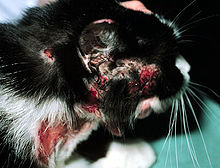
Cats exposed to allergens may develop allergies or allergic reactions. Allergies tend to become evident and intensify over extended periods of time and can take years to develop.[1] Some allergic diseases and allergies in cats include feline atopic dermatitis, flea allergy dermatitis, feline-mosquito hypersensitivity, and food-induced allergy. In the case of feline atopy, hypersensitivity to allergens is due to genetic predisposition. However, various allergies may arise due to environmental factors. Allergens, ingested, inhaled, or airborne, can be seasonal or non-seasonal, similar to allergies in humans.[2] Suspected seasonal allergens include but are not limited to pollen, fleas, and mosquito bites; suspected non-seasonal allergens include but are not limited to plastic materials, food, dust, trees, and grass. After exposure to suspected allergens, symptoms may be immediate or delayed, arising within a few minutes to two hours. Symptoms can include both dermatological and gastrointestinal signs[3] such as itchy skin, hair loss and excessive scratching. In cases of feline atopic dermatitis or atopy in cats, pruritic skin diseases may result; however, signs can also include miliary dermatitis, symmetrical alopecia, and lesions of the eosinophilic granuloma complex.[4]
Food allergies account for approximately 10% of allergies in both dogs and cats.[5] Food allergies are often mistaken for food intolerances, which can result in vomiting and diarrhea instead of dermal issues. In most cases where food allergies occur, they do so with foods that cats eat most often. Common food allergens in cats include beef, dairy, fish, eggs, and chicken. Preservatives and other additives are also occasionally involved in triggering an allergic reaction.[6] There is no specific breed or age range that food allergies target; however, there are certain breeds that are more susceptible to food allergies than others.[7] For example, Siamese and Siamese crosses may have a higher risk of food allergies than other breeds.[7]
- ^ "Feline Food Allergies". www.vet.cornell.edu. Retrieved 2017-11-29.
- ^ "Feline Atopic Dermatitis - Integumentary System - Merck Veterinary Manual". Merck Veterinary Manual. Retrieved 2018-01-02.
- ^ Guaguère, E (1995). "Food intolerance in cats with cutaneous manifestations: a review of 17 cases". European Journal of Companion Animal Practice. 5: 27–35.
- ^ DACVD, Hilary A. Jackson BVM&S DVD. "Dermatologic manifestations and nutritional management of adverse food reactions". dvm360.com. Retrieved 2017-11-29.
- ^ Scott, D. (2001). "Skin Immune System and Allergic Skin Diseases". Muller & Kirk's Small Animal Dermatology. pp. 543–666. doi:10.1016/B978-0-7216-7618-0.50012-2. ISBN 978-0-7216-7618-0.
- ^ Carlotti, Didier N. (2013). "Cutaneous Manifestations of Food Hypersensitivity". Veterinary Allergy. pp. 108–114. doi:10.1002/9781118738818.ch16. ISBN 978-1-118-73881-8.
- ^ a b Carlotti, Didier N.; Remy, Isabelle; Prost, Christine (1990-06-01). "Food Allergy In Dogs And Cats. A Review and Report of 43 Cases". Veterinary Dermatology. 1 (2): 55–62. doi:10.1111/j.1365-3164.1990.tb00080.x. ISSN 1365-3164. PMID 34233395.